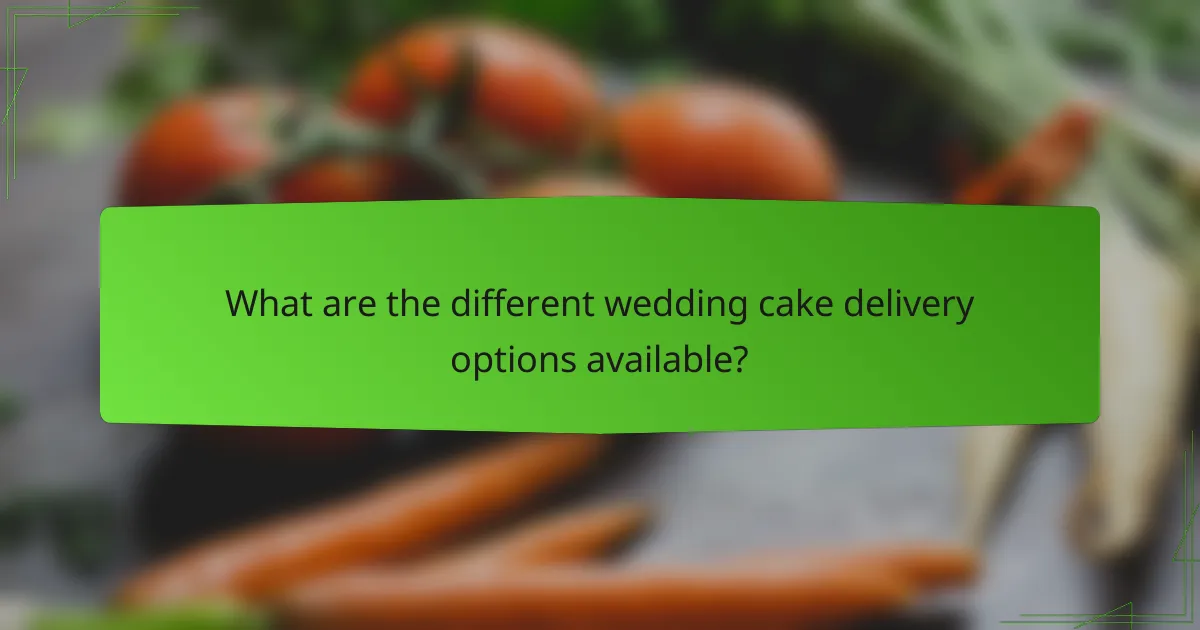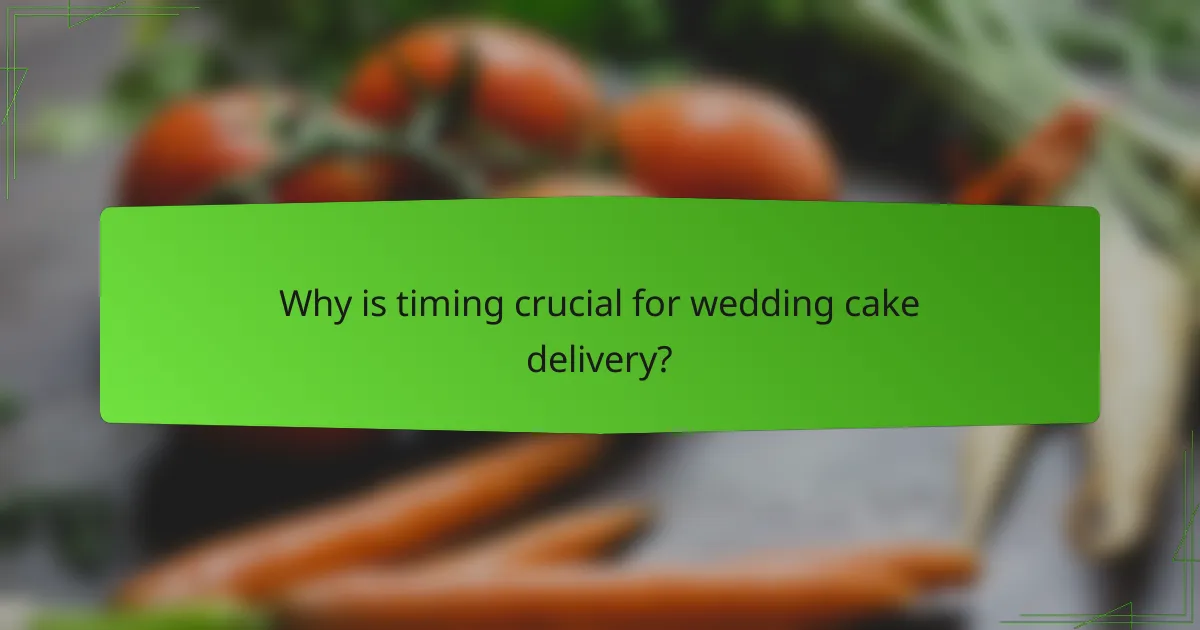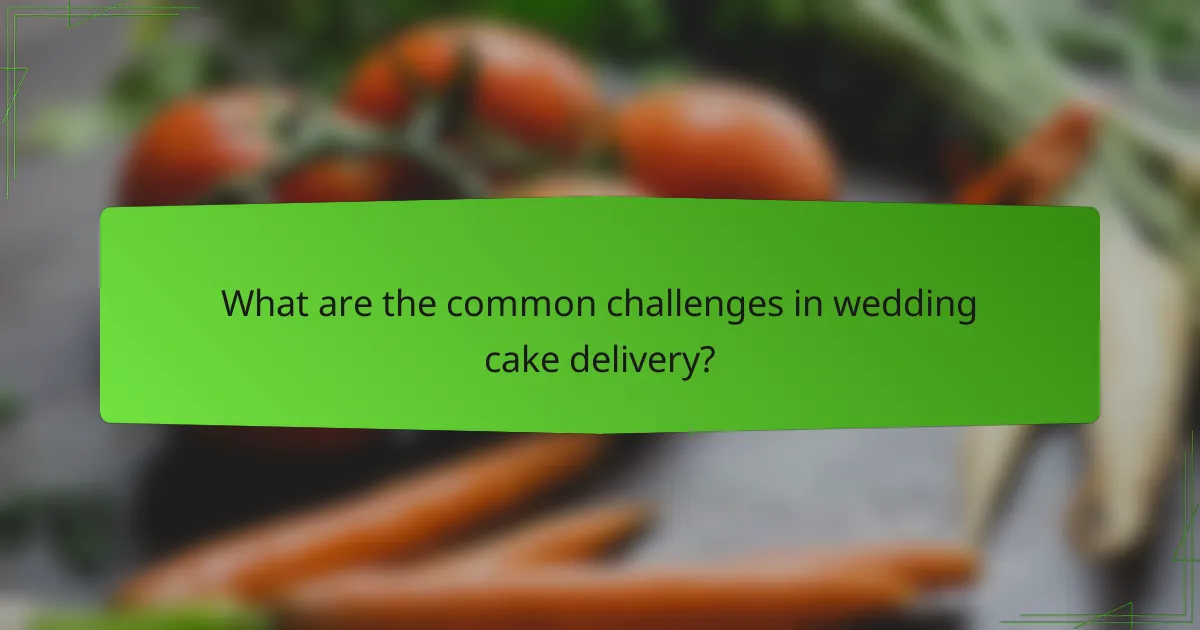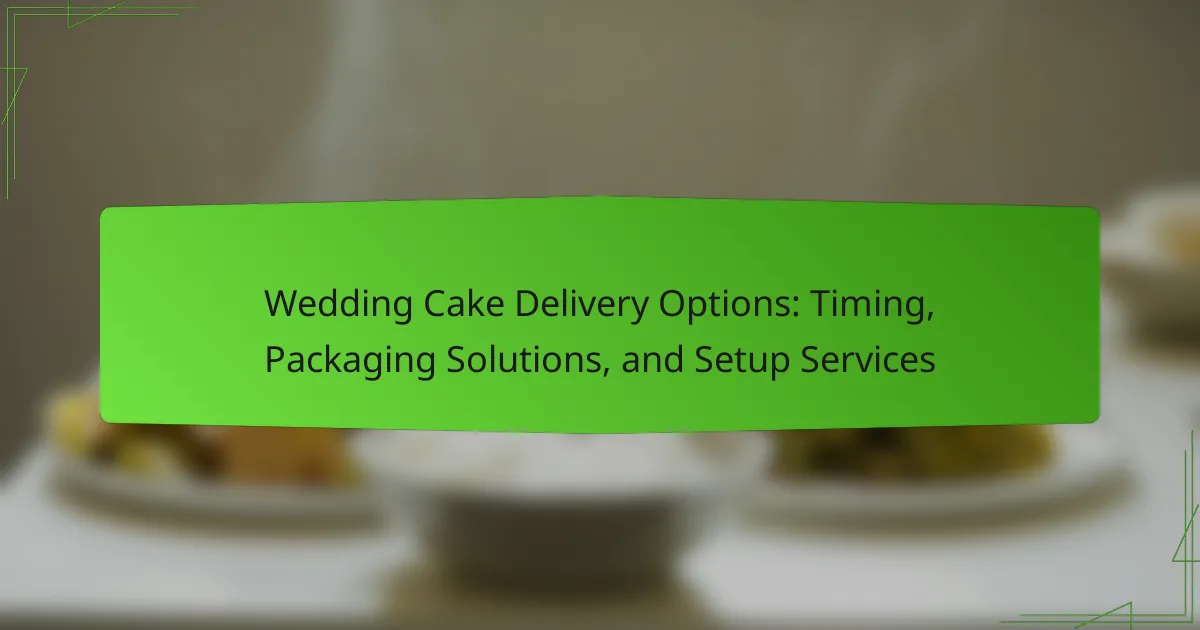
What are the different wedding cake delivery options available?
The different wedding cake delivery options available include direct delivery, pickup, and third-party delivery services. Direct delivery involves the bakery transporting the cake to the venue. This option ensures the cake is handled by professionals. Pickup allows the couple to collect the cake from the bakery themselves. This option may save on delivery costs. Third-party delivery services can also be used. These services may offer flexibility but can introduce risks regarding handling. Each option has its pros and cons, depending on the couple’s preferences and logistics.
How do timing considerations impact wedding cake delivery?
Timing considerations significantly impact wedding cake delivery by influencing freshness and presentation. Cakes must be delivered close to the event time to maintain optimal taste and texture. Delays can lead to drying or spoilage, affecting the overall quality. Additionally, timing affects the logistics of transportation and setup. Bakers often schedule deliveries based on the wedding timeline to ensure the cake is ready for display. For example, a cake delivered too early may require refrigeration, which can alter its appearance. Proper timing ensures that the cake arrives in pristine condition, enhancing the event experience.
What is the ideal time frame for ordering a wedding cake?
The ideal time frame for ordering a wedding cake is typically 6 to 12 months before the wedding date. This allows ample time for consultations, tastings, and design finalizations. Many bakeries require this lead time to ensure quality and availability. Ordering early helps avoid last-minute stress and allows for adjustments if needed. Additionally, peak wedding seasons may require even earlier orders to secure a preferred baker. Planning ahead ensures a smooth process and a cake that meets expectations.
How does the delivery time vary based on cake size and complexity?
Delivery time increases with cake size and complexity. Larger cakes require more time for preparation and transportation. Complex designs involve intricate assembly and decoration, which also extends delivery time. For example, a simple two-tier cake may take 1-2 hours for delivery. In contrast, a multi-tier cake with elaborate designs may take 3-5 hours. Additionally, delivery distance impacts timing. Cakes delivered locally may arrive faster than those requiring long-distance transport. Overall, both size and complexity significantly influence the delivery timeline.
What packaging solutions are best for wedding cake delivery?
Sturdy cake boxes are the best packaging solutions for wedding cake delivery. These boxes provide essential support and protection during transportation. They are typically made from corrugated cardboard or high-quality paperboard. Cake boxes should be designed to securely hold the cake in place. This prevents movement and potential damage. Additionally, boxes with inserts can help stabilize multi-tier cakes. Ventilation holes are beneficial for air circulation, reducing moisture buildup. Using a non-slip base can further enhance stability during delivery. These features ensure the cake arrives intact and presentable for the event.
What types of packaging materials are recommended for preserving cake freshness?
Plastic wrap, airtight containers, and cake boxes are recommended for preserving cake freshness. Plastic wrap tightly seals the cake, preventing air exposure. Airtight containers offer a similar benefit by keeping moisture in. Cake boxes provide protection from physical damage and contaminants. Each of these materials helps maintain the cake’s texture and flavor. Studies show that proper packaging can extend cake freshness by several days. Using these materials can significantly reduce staleness and spoilage.
How can packaging prevent damage during transport?
Packaging prevents damage during transport by providing structural support and cushioning. Strong materials like corrugated cardboard or rigid boxes are used to protect the contents. This support minimizes movement and impact during transit. Cushioning materials such as bubble wrap or foam inserts absorb shocks. Properly designed packaging also helps distribute weight evenly. This reduces the risk of crushing or breaking. Additionally, secure sealing methods can prevent moisture exposure. Research shows that effective packaging reduces damage rates by up to 30%. Proper packaging is crucial for delicate items like wedding cakes.
What setup services are available for wedding cake delivery?
Setup services for wedding cake delivery typically include cake assembly, decoration placement, and tier stabilization. These services ensure the cake is presented beautifully at the venue. Many bakeries offer to set up the cake at the designated location. They may also provide tools to secure the tiers and ensure stability. Some services include adding decorative elements such as fresh flowers or cake toppers. Delivery teams are trained to handle delicate cakes to prevent damage during setup. This service enhances the overall presentation and experience for the event.
How do setup services enhance the presentation of the wedding cake?
Setup services enhance the presentation of the wedding cake by ensuring it is displayed beautifully at the venue. These services arrange the cake in a visually appealing manner. They often utilize decorative elements like stands, flowers, and lighting to elevate the cake’s appearance. Professional setup also ensures that the cake is stable and positioned correctly. This prevents any mishaps during the event. A well-presented cake becomes a focal point for guests. It enhances the overall aesthetic of the wedding reception. Proper setup contributes to creating memorable photo opportunities.
What should couples consider when choosing a setup service?
Couples should consider the service’s experience and reputation when choosing a setup service. Experienced services are more likely to handle cakes delicately and efficiently. Reputation can be assessed through reviews and testimonials from previous clients. Couples should also evaluate the setup service’s availability on their wedding date. Confirming this helps avoid last-minute issues. Additionally, couples should inquire about the service’s insurance coverage. Insurance protects against potential damage during transportation and setup. Lastly, couples should discuss pricing and packages offered. Clear communication about costs helps in budgeting effectively.

Why is timing crucial for wedding cake delivery?
Timing is crucial for wedding cake delivery to ensure freshness and quality. A wedding cake is typically made a day or two before the event. Delivering it too early can lead to spoilage or drying out. Conversely, late delivery can disrupt the wedding schedule and cause stress for the couple. Many cakes require specific temperature controls to maintain their structure and flavor. For instance, fondant-covered cakes can melt if exposed to heat for too long. Proper timing also allows for setup and decoration adjustments. Ensuring timely delivery helps maintain the cake’s visual appeal and taste, which are vital for the event.
How does the timing of delivery affect the cake’s quality?
The timing of delivery significantly impacts a cake’s quality. Freshness is crucial for maintaining flavor and texture. Cakes delivered too early may dry out or lose their intended moisture. Conversely, late deliveries can lead to temperature issues, affecting icing stability. Specific ingredients, such as cream or fruit, may spoil if not delivered promptly. Proper timing ensures the cake remains visually appealing and structurally sound. According to a study from the Culinary Institute, cakes are best consumed within 24 hours of baking for optimal taste. Thus, timely delivery is essential for preserving a cake’s quality.
What are the risks of late deliveries for wedding cakes?
Late deliveries for wedding cakes can lead to significant issues. The cake may not be fresh, affecting its taste and texture. A delayed cake can disrupt the wedding timeline. Guests may experience disappointment if the cake is not available for the celebration. Additionally, a late delivery can cause stress for the couple and wedding planners. The cake might require extra setup time, which can complicate the event. Ultimately, these risks can tarnish the overall wedding experience.
How can early delivery benefit the overall wedding setup?
Early delivery can significantly enhance the overall wedding setup. It allows ample time for proper arrangement and adjustments. Vendors can address any unforeseen issues before the ceremony begins. Early delivery also ensures that the wedding cake remains fresh and visually appealing. This timing reduces stress for the wedding planner and the couple. Additionally, it provides an opportunity for last-minute decorations or changes. Overall, early delivery contributes to a smoother, more organized wedding experience.

What are the common challenges in wedding cake delivery?
Common challenges in wedding cake delivery include damage during transport, temperature control issues, and timely arrival. Transporting a multi-tiered cake can lead to structural instability. Uneven surfaces or sudden stops can cause shifting or collapse. Temperature fluctuations can affect frosting and filling, leading to melting or spoilage. Timeliness is critical; delays can impact the wedding schedule. Additionally, securing proper packaging is essential to protect the cake. Poor packaging can result in breakage or deformation. These factors highlight the complexity of delivering wedding cakes successfully.
How can couples ensure their wedding cake arrives safely?
Couples can ensure their wedding cake arrives safely by selecting a reliable bakery and delivery service. They should communicate clearly about the cake’s design and transport requirements. Couples can schedule the delivery for a time close to the ceremony. Using sturdy packaging helps protect the cake during transit. Couples should also confirm that the delivery vehicle is suitable for transporting delicate items. If possible, they can arrange for a designated person to oversee the delivery. This ensures that the cake is handled properly upon arrival. Following these steps can minimize the risk of damage during transportation.
What precautions should be taken during transport?
Ensure the wedding cake is securely packaged before transport. Use a sturdy box designed for cakes to prevent movement. Keep the cake level during transport to avoid shifting. Maintain a stable temperature to prevent melting or damage. Avoid direct sunlight and high temperatures inside the vehicle. Use non-slip mats in the transport vehicle to stabilize the cake. Plan the route to minimize bumps and delays. Confirm delivery timing to ensure freshness upon arrival.
How can couples communicate effectively with their cake vendor?
Couples can communicate effectively with their cake vendor by being clear and specific about their needs. They should provide details about the desired cake design, flavors, and size. Clear timelines for delivery and setup should also be discussed upfront. Couples should ask about the vendor’s policies on changes and cancellations. Regular follow-ups can help ensure that all details are confirmed. Documenting conversations can prevent misunderstandings. Providing visual references, such as photos, can help convey their vision. Open and honest communication fosters a positive relationship with the vendor.
What are the best practices for wedding cake delivery and setup?
The best practices for wedding cake delivery and setup include timely delivery, proper packaging, and careful setup. Timely delivery ensures the cake arrives fresh and in perfect condition. Aim for delivery at least one to two hours before the event begins. Proper packaging protects the cake during transport. Use sturdy boxes and secure it with non-slip materials. Careful setup involves placing the cake on a stable, level surface. Ensure the cake is displayed away from direct sunlight and heat sources. Additionally, have a designated area for the cake to avoid crowding. Following these practices helps maintain the cake’s quality and presentation.
How can couples prepare for the delivery day?
It is not possible to provide a relevant answer to the question regarding how couples can prepare for the delivery day in the context of wedding cake delivery options. The question does not align with the topic specified.
What tips can ensure a seamless cake setup at the venue?
To ensure a seamless cake setup at the venue, coordinate with the venue staff in advance. Confirm the setup time and location for the cake. Use sturdy packaging to protect the cake during transport. Consider the cake’s size and weight when choosing delivery methods. Ensure the venue has a stable and level surface for the cake display. Provide clear instructions for the setup team regarding decoration and presentation. Monitor temperature and humidity levels to prevent cake damage. Lastly, have a backup plan for any unexpected issues during setup.
The main entity of this article is wedding cake delivery options. It provides a comprehensive overview of various delivery methods, including direct delivery, pickup, and third-party services, along with their pros and cons. The article emphasizes the importance of timing for maintaining cake quality, outlines the ideal ordering timeframe, and discusses how cake size and complexity affect delivery logistics. It also highlights effective packaging solutions to preserve freshness and prevent damage during transport, as well as setup services that enhance the cake’s presentation at the venue. Key considerations for couples when selecting delivery and setup services are also addressed, ensuring a successful wedding cake experience.
